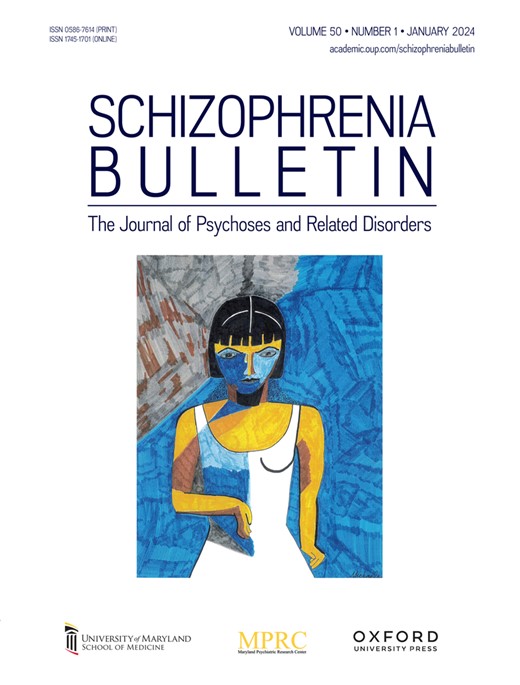中年精神病患者认知能力下降的筛查:使用纵向数据检查临床痴呆评分
IF 5.3
1区 医学
Q1 PSYCHIATRY
引用次数: 0
摘要
背景和假设对于精神病患者中痴呆的高发病率是否反映了精神病发病时存在的损害,人们知之甚少。我们假设,依赖纵向数据将有助于区分与精神障碍相关的稳定缺陷与随后的衰退。研究设计:前瞻性评估首次入院精神病患者的临床痴呆评分(CDR),随访25年(109例精神分裂症;135名其他精神病患者)和238名人口统计学上匹配的无精神病成年人。我们使用在25年随访评估中仅收集一次的数据和25年前基线的变化对CDR盒的总和进行评分。损伤分类为未观察到(NI: CDR <;2.4),轻度-中度(MI: 2.4≤CDR;4.8)或严重(SI;CDR≥4.8)。评估各临床组MI/SI的发生率。采用多项逻辑回归估计多变量调整风险比(aRR)。研究结果:横断面评估时MI/SI很常见,但采用纵向评分时患病率下降了44.4-65.9%。使用纵向数据,11.6%/18.2%的精神分裂症患者和9.1%/3.8%的其他精神病患者分别患有MI/SI。精神分裂症患者发生心肌梗死(aRR = 4.98, 95% CI, 1.85-13.46, P = 0.002)和SI (aRR = 25.98 [3.50-192.75] P = 0.001)的风险高于无精神病的成年人。其次,纯合子载脂蛋白-ε4携带者(占基因型参与者的2.6%)精神分裂症患者在中年发生SI的风险较高(SRR = 2.57 [1.04-6.33] P = 0.04)。结论未来的工作应包括观察到的认知和功能下降,以检查精神病患者的认知障碍。CDR评分的变化在治疗时可能很重要。本文章由计算机程序翻译,如有差异,请以英文原文为准。
Screening for Cognitive Decline in Psychotic Disorders in Midlife: Examining Scoring the Clinical Dementia Rating Using Longitudinal Data
Background and Hypothesis Little is understood about whether the high reported prevalence of dementia in people with psychosis reflects impairment present at psychosis onset. We hypothesized that relying on longitudinal data would help to distinguish stable deficits associated with psychotic disorders from subsequent decline. Study Design We prospectively assessed the Clinical Dementia Rating (CDR) in individuals with first-admission psychosis who have been followed for 25 years (109 with schizophrenia; 135 with other psychoses) alongside 238 demographically matched never-psychotic adults. We scored the CDR sum of boxes using data collected only once at the 25-year follow-up assessment and as a change from baseline, 25 years prior. Impairment was categorized as not observed (NI: CDR < 2.4), mild–moderate (MI: 2.4 ≤ CDR < 4.8), or severe (SI; CDR ≥ 4.8). Prevalence of MI/SI by clinical group was assessed. Multivariable-adjusted risk ratios (aRR) were estimated using multinomial logistic regression. Study Results MI/SI was common when assessed cross-sectionally, but prevalence decreased by 44.4–65.9% when longitudinal scoring was applied. Using longitudinal data, 11.6%/18.2% of participants with schizophrenia and 9.1%/3.8% of those with other psychosis had MI/SI respectively. Participants with schizophrenia were at an increased risk of MI (aRR = 4.98, 95% CI, 1.85–13.46, P = .002) and SI (aRR = 25.98 [3.50–192.75] P = .001) relative to never-psychotic adults. Secondarily, homozygotic apolipoprotein-ε4 carriers (2.6% of genotyped participants) with schizophrenia were at higher risk for SI at midlife (SRR = 2.57 [1.04–6.33] P = .04). Conclusions Future work should include observed decline in cognition and functioning to examine cognitive impairment in psychosis. Changes in CDR score may be important when managing treatment.
求助全文
通过发布文献求助,成功后即可免费获取论文全文。
去求助
来源期刊

Schizophrenia Bulletin
医学-精神病学
CiteScore
11.40
自引率
6.10%
发文量
163
审稿时长
4-8 weeks
期刊介绍:
Schizophrenia Bulletin seeks to review recent developments and empirically based hypotheses regarding the etiology and treatment of schizophrenia. We view the field as broad and deep, and will publish new knowledge ranging from the molecular basis to social and cultural factors. We will give new emphasis to translational reports which simultaneously highlight basic neurobiological mechanisms and clinical manifestations. Some of the Bulletin content is invited as special features or manuscripts organized as a theme by special guest editors. Most pages of the Bulletin are devoted to unsolicited manuscripts of high quality that report original data or where we can provide a special venue for a major study or workshop report. Supplement issues are sometimes provided for manuscripts reporting from a recent conference.
 求助内容:
求助内容: 应助结果提醒方式:
应助结果提醒方式:


